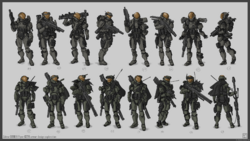MIRAGE Semi-Powered Infiltration Armor
From Halo: Daybreak
| This article is currently under construction. As the subject is under active development, information here may not yet be final. |
The MIRAGE Semi-Powered Infiltration Armor is a stealth-focused power armor system used by the UNSC's special forces, mainly the Spartan-IIIs and later ODSTs, specifically those of the Hoplite program. Designated only as the Semi-Powered Infiltration armor or SPI until its third major generation, the MIRAGE system uses advanced photoreactive coating to conceal its wearer from view. The SPI existed as a fairly obscure, experimental platform used mainly by the Spartan-IIIs until its third generation, when its formal name was also codified. In contrast to MJOLNIR, MIRAGE remains fully compatible with non-augmented or lightly-augmented physiologies, and various ONI, ODST and NAVSPECWAR units have already begun fielding it. In addition, MIRAGE is also considerably cheaper and easier to manufacture, which makes it a more economical alternative to MJOLNIR.
Development[edit | edit source]
Predecessors[edit | edit source]
Mark I (2532)[edit | edit source]
The initial production model of SPI armor, the Mark I included a basic set of features:
- Hermetically sealed bodysuit with vacuum survivability kit
- First-generation photoreactive plating
Mark II[edit | edit source]
- Series 1 (2540)
- Enhanced photoreactive coating
- Biofoam/combat pharmaceutical injection ports
- Series 2 (2551)
- Enhanced photoreactive coating
- Integrated biofoam dispensers
- Added shock plate reactive shield system
Mark III[edit | edit source]
Introduced in 2555, the third generation marks a remarkable upgrade of the SPI system, incorporating various advances made throughout the war in other power armor programs such as Project MJOLNIR, the ODST armor, and the Army Airborne's VALKYRIE systems.
Upgrades to the third-generation SPI include:
- Upgrades to the suit's physical architecture and armor; improved comfort and range of motion
- Added insets of semi-rigid blast-resistant armor padding in critical areas, at the cost of some mobility in some areas (e.g. the abdomen)
- Added padding and adjustment options to reduce chafing and weight
- Minor improvements to armor composition and materials; the suit is now slightly heavier due to added protection, something that is partly mitigated by improvements in power assist.
- More modular component design to improve mission configurability, bringing the suit up to date with the M43 Universal Combatant Equipment System standard
- More options for gear attachment
- The suit uses a newer standard of universal helmet seal, and the electronics integration is smoother
- Improved attachment hardpoints and magnetic clamps.
- Overhaul of the helmet and associated software suites
- Electronics: numerous improvements e.g. to active hearing protection (fully filtered sensory environment), improved comms, smart-linking, etc
- Improved CRBN filtering system + modern HAZOP module attachments and integration
- Improved electronics hardening
- The undersuit now has an internal environment that regulates temperature and moisture. It stops being entirely comfortable after a point, but can theoretically be worn for up to 72 hours straight while fully enclosed.
- Should be worn with a dedicated (or otherwise compatible) technical undergarment.
- There is a rudimentary, if optional, removal system for liquid waste. Most opt not to use this as it remains fairly cumbersome, though future upgrades may remedy this.
- The undersuit's limited power assist exo-frame has been slightly improved to better distribute weight. Still, the suit does very little actual movement or strength-enhancement; while it could be adjusted to do so, this would present considerable power drain
- Improved photoreactive chameleoglage system with superior pattern-generation software and full IR detection shielding
- Strike shielding system with enhanced coverage; however, the continued reliance on batteries means the shields cannot be recharged multiple times without compromising armor functionality.
- Overhauled power system; the battery-packs have been replaced by more efficient ones


